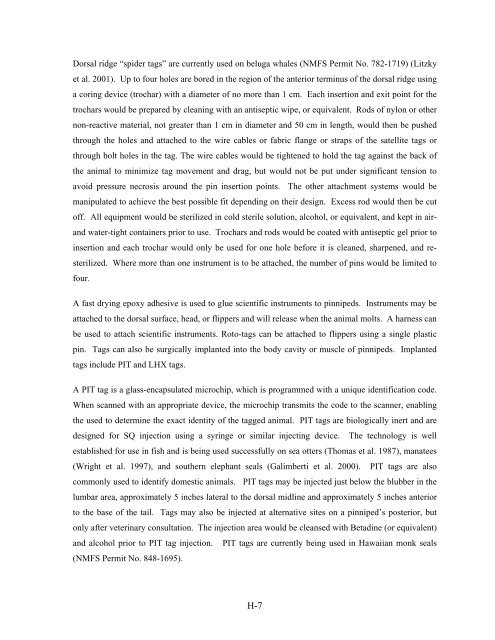Volume III, Appendices EM - National Marine Fisheries Service ...
Volume III, Appendices EM - National Marine Fisheries Service ...
Volume III, Appendices EM - National Marine Fisheries Service ...
You also want an ePaper? Increase the reach of your titles
YUMPU automatically turns print PDFs into web optimized ePapers that Google loves.
Dorsal ridge “spider tags” are currently used on beluga whales (NMFS Permit No. 782-1719) (Litzky<br />
et al. 2001). Up to four holes are bored in the region of the anterior terminus of the dorsal ridge using<br />
a coring device (trochar) with a diameter of no more than 1 cm. Each insertion and exit point for the<br />
trochars would be prepared by cleaning with an antiseptic wipe, or equivalent. Rods of nylon or other<br />
non-reactive material, not greater than 1 cm in diameter and 50 cm in length, would then be pushed<br />
through the holes and attached to the wire cables or fabric flange or straps of the satellite tags or<br />
through bolt holes in the tag. The wire cables would be tightened to hold the tag against the back of<br />
the animal to minimize tag movement and drag, but would not be put under significant tension to<br />
avoid pressure necrosis around the pin insertion points. The other attachment systems would be<br />
manipulated to achieve the best possible fit depending on their design. Excess rod would then be cut<br />
off. All equipment would be sterilized in cold sterile solution, alcohol, or equivalent, and kept in airand<br />
water-tight containers prior to use. Trochars and rods would be coated with antiseptic gel prior to<br />
insertion and each trochar would only be used for one hole before it is cleaned, sharpened, and resterilized.<br />
Where more than one instrument is to be attached, the number of pins would be limited to<br />
four.<br />
A fast drying epoxy adhesive is used to glue scientific instruments to pinnipeds. Instruments may be<br />
attached to the dorsal surface, head, or flippers and will release when the animal molts. A harness can<br />
be used to attach scientific instruments. Roto-tags can be attached to flippers using a single plastic<br />
pin. Tags can also be surgically implanted into the body cavity or muscle of pinnipeds. Implanted<br />
tags include PIT and LHX tags.<br />
A PIT tag is a glass-encapsulated microchip, which is programmed with a unique identification code.<br />
When scanned with an appropriate device, the microchip transmits the code to the scanner, enabling<br />
the used to determine the exact identity of the tagged animal. PIT tags are biologically inert and are<br />
designed for SQ injection using a syringe or similar injecting device. The technology is well<br />
established for use in fish and is being used successfully on sea otters (Thomas et al. 1987), manatees<br />
(Wright et al. 1997), and southern elephant seals (Galimberti et al. 2000). PIT tags are also<br />
commonly used to identify domestic animals. PIT tags may be injected just below the blubber in the<br />
lumbar area, approximately 5 inches lateral to the dorsal midline and approximately 5 inches anterior<br />
to the base of the tail. Tags may also be injected at alternative sites on a pinniped’s posterior, but<br />
only after veterinary consultation. The injection area would be cleansed with Betadine (or equivalent)<br />
and alcohol prior to PIT tag injection. PIT tags are currently being used in Hawaiian monk seals<br />
(NMFS Permit No. 848-1695).<br />
H-7
















